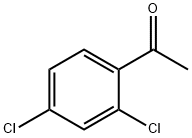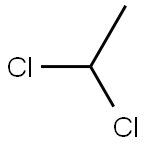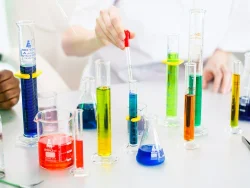1,4-Dichloro-2-butyne
- CAS NO.:821-10-3
- Empirical Formula: C4H4Cl2
- Molecular Weight: 122.98
- MDL number: MFCD00000981
- EINECS: 212-474-8
- SAFETY DATA SHEET (SDS)
- Update Date: 2025-09-25 17:15:13

What is 1,4-Dichloro-2-butyne?
Chemical properties
CLEAR COLORLESS TO YELLOWISH LIQUID
The Uses of 1,4-Dichloro-2-butyne
1,4-Dichloro-2-butyne used in the synthesis of 1,4-disubstituted 1,2,3-triazoles. Also, it is used in the approach of the 20S-camptothecin family of antitumor agents.
Safety Profile
Poison by intravenous route. When heated to decomposition it emits toxic fumes of Cl-. Probably a dangerous fKe and explosion hazard. See also ACETYLENE COMPOUNDS and CHLORINATED HYDROCARBONS, ALIPHATIC
Properties of 1,4-Dichloro-2-butyne
| Melting point: | 162-165 °C |
| Boiling point: | 165-168 °C (lit.) |
| Density | 1.258 g/mL at 25 °C (lit.) |
| refractive index | n |
| Flash point: | 320 °F |
| storage temp. | Keep in dark place,Sealed in dry,Room Temperature |
| solubility | Chloroform (Slightly), DMSO (Slightly), Methanol (Slightly) |
| form | Oil |
| color | Clear Colourless |
| Sensitive | Light Sensitive |
| BRN | 635740 |
| CAS DataBase Reference | 821-10-3(CAS DataBase Reference) |
| NIST Chemistry Reference | 2-Butyne, 1,4-dichloro-(821-10-3) |
| EPA Substance Registry System | 1,4-Dichloro-2-butyne (821-10-3) |
Safety information for 1,4-Dichloro-2-butyne
| Signal word | Warning |
| Pictogram(s) |
 Skull and Crossbones Acute Toxicity GHS06  Exclamation Mark Irritant GHS07 |
| GHS Hazard Statements |
H301:Acute toxicity,oral H315:Skin corrosion/irritation H319:Serious eye damage/eye irritation H335:Specific target organ toxicity, single exposure;Respiratory tract irritation |
| Precautionary Statement Codes |
P261:Avoid breathing dust/fume/gas/mist/vapours/spray. P264:Wash hands thoroughly after handling. P264:Wash skin thouroughly after handling. P270:Do not eat, drink or smoke when using this product. P280:Wear protective gloves/protective clothing/eye protection/face protection. P305+P351+P338:IF IN EYES: Rinse cautiously with water for several minutes. Remove contact lenses, if present and easy to do. Continuerinsing. P405:Store locked up. P501:Dispose of contents/container to..… |
Computed Descriptors for 1,4-Dichloro-2-butyne
| InChIKey | RCHDLEVSZBOHOS-UHFFFAOYSA-N |
1,4-Dichloro-2-butyne manufacturer
New Products
4,4-Difluoropiperidine hydrochloride tert-butyl 9-methoxy-3-azaspiro[5.5]undecane-3-carboxylate Indole Methyl Resin N-Isopropylurea N,N-Dicyclohexylcarbodiimide(DCC) MELDRUMS ACID 5-METHYLISOXAZOLE-4-CARBOXYLIC ACID Magnessium Bis glycinate Zinc ascorbate 1-bromo-2-butyne 2-acetamidophenol 9(10H)-anthracenone Erythrosin B, 4-Piperidinopiperidine 2-((4-morpholinophenylamino) (methylthio) methylene) malononitrile 2,4-dihydroxybenzaldehyde 3-(4-morpholinophenylamino)-5-amino-1H-pyrazole-4-carbonitrile Methyl 2-methylquinoline-6-carboxylate 2,6-dichloro-4-nitropyridine 4-Bromo-2-chlorobenzonitrile 2-(benzylamino)acetic acid hydrochloride 4-(tert-Butoxycarbonylamino)but- 2-ynoic acid 3,4-dihydro-2H-benzo[b][1,4]dioxepine 1-Phenyl-1-cycloprppanecarboxylicacidRelated products of tetrahydrofuran








You may like
-
 821-10-3 1,4-Dichloro-2-butyne 98%View Details
821-10-3 1,4-Dichloro-2-butyne 98%View Details
821-10-3 -
 821-10-3 98%View Details
821-10-3 98%View Details
821-10-3 -
 1,4-Dichloro-but-2-yne 821-10-3 98%View Details
1,4-Dichloro-but-2-yne 821-10-3 98%View Details
821-10-3 -
 1,4-Dichloro-2-butyne, 97% CAS 821-10-3View Details
1,4-Dichloro-2-butyne, 97% CAS 821-10-3View Details
821-10-3 -
 1,4-Dichloro-2-butyne CAS 821-10-3View Details
1,4-Dichloro-2-butyne CAS 821-10-3View Details
821-10-3 -
 1,4-Dichloro-2-butyne CAS 821-10-3View Details
1,4-Dichloro-2-butyne CAS 821-10-3View Details
821-10-3 -
 Hdpe 1 4 Dichloro 2 Butyne Cas No 821-10-3, For Industrial, LiquidView Details
Hdpe 1 4 Dichloro 2 Butyne Cas No 821-10-3, For Industrial, LiquidView Details
821-10-3 -
 1,4-Dichloro-2-ButyneView Details
1,4-Dichloro-2-ButyneView Details
821-10-3
Statement: All products displayed on this website are only used for non medical purposes such as industrial applications or scientific research, and cannot be used for clinical diagnosis or treatment of humans or animals. They are not medicinal or edible.
